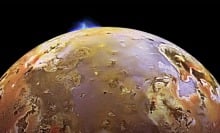Zooming through the outer reaches of the solar system, A NASA spacecraft just clocked a distance 60 times farther from the sun than Earth.
The extraordinary benchmark announced this week means the New Horizons probe has doubled its 2015 distance, when it was snapping pictures of Pluto and its moons.
Perhaps more surprising than this intangible deep-space milestone is the one this intrepid spacecraft hasn't reached yet: the outer edge of the solar system's Kuiper Belt, a disk beyond Neptune of countless comets and thousands of tiny ice worlds. The far-flung region is littered with leftover rubble from the time when primitive planets were forming.
Scientists had expected the spacecraft to arrive at the proverbial edge about 1 billion miles ago.
"Our Solar System’s Kuiper Belt long appeared to be very small in comparison with many other planetary systems," said Wes Fraser, a co-investigator for the New Horizons mission, in a statement, "but our results suggest that idea might just have arisen due to an observational bias."

While the spacecraft has whizzed away at 300 million miles per year, the New Horizons team has continued to collect data about the Kuiper Belt.
October Prime Day: Here's the latest news on the deals
More on Prime Day: Here are all the best deals to shop so far
What's more, using the Japanese Subaru Telescope in Hawaii, New Horizon's scientists detected a population of previously unknown cosmic objects. The group could be sprawled out to almost 90 times as far as Earth is from the sun, according to a recent paper published in the Planetary Science Journal.
The discovery suggests the Kuiper Belt may span much farther than once thought, or that there is perhaps another such belt even farther away than the one scientists have known about since the 1990s. The new finding could mean the spacecraft has a longer journey ahead — on the scale of billions of more miles — before it gets to interstellar space, the place outside the region affected by the sun’s constant flow of material.

"Maybe, if this result is confirmed, our Kuiper Belt isn’t all that small and unusual after all, compared to those around other stars," Fraser said.
Scientists don't know much about the new population of objects yet, but one possibility is that Neptune's gravity is affecting the group, causing its orbit to be a precise multiple of the planet's. Regardless, their mere existence would seem to meddle with conventional ideas about how the solar system formed, perhaps indicating planetary material came from a much larger vicinity than previously thought.
New Horizons launched in early 2006, first visiting Jupiter for a gravity boost and scientific studies in 2007. Nine years into its mission, it flew by Pluto. Then, on Jan. 1, 2019, it arrived at its next major target, a Kuiper Belt object roughly 4 billion miles from Earth. This icy red dumbbell-shaped world, only 21 miles wide, is the farthest object a spacecraft has ever encountered. The team officially named it Arrokoth, a Powhatan and Algonquian word meaning "sky," after the Latin first choice sparked controversy for having icky associations with Nazis.

The spacecraft's life expectancy lasts until 2050, said planetary scientist Alan Stern, who's directing the mission for NASA. It has enough power and fuel to continue operating beyond a distance 100 times farther from the sun than Earth.
If it does survive the trek into interstellar space, it won't be the first to get there. Voyager 1 and Voyager 2, both launched in 1977, have each drifted outside the solar system, at over 15 billion and 12 billion miles from Earth, respectively.
Topics NASA















